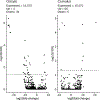Effects of early lactation body condition loss in dairy cows on serum lipid profiles and on oocyte and cumulus cell transcriptomes
- PMID: 35940920
- PMCID: PMC10795684
- DOI: 10.3168/jds.2022-21919
Effects of early lactation body condition loss in dairy cows on serum lipid profiles and on oocyte and cumulus cell transcriptomes
Abstract
The objective of this study was to determine the effect of early lactation body condition (BC) loss in multiparous dairy cows on serum lipids and the effect of these changes on oocyte and cumulus cell transcriptomes. Body condition loss in dairy cattle after parturition is associated with reduced fertility and increased pregnancy loss. The complex interplay between BC, nutrition, dry matter intake, milk production, and time of calving has presented a barrier to understanding mechanisms leading to reduced fertility. We identified cows that lost BC (L group; n = 10) or maintained or gained BC (M/G group; n = 8) during the first 27 to 33 d in milk and investigated changes in serum fatty acids and oocyte and cumulus cell transcriptomes at 75 to 81 d in milk. The L group had increased serum levels of nonesterified fatty acids and mead acid, and reduced serum levels of petroselaidic acid and behenic acid. Transcriptome analyses revealed 38 differentially expressed genes (DEG) in oocytes and 71 DEG in cumulus cells of L (n = 3) compared with M/G group (n = 3). Network analysis connected serum fatty acid changes to downstream effects including reduced inflammatory response and mitochondrial membrane depolarization, increased production of reactive oxygen species, and functions related to fatty acid metabolism and cytoplasmic organization in oocytes. These effects were associated with predicted effects on signaling in oocytes through calcium, insulin, O-GlcNAcase (OGA), fibroblast growth factor receptor 4 (FGF4R), peroxisome proliferator activated receptor gamma coactivator 1 α (PPARGC1A), and phospholipase D2 (PLD2) pathways, with a connection to the cumulus cell via calcium signaling. These results connect BC loss following parturition to changes in serum lipid levels, and changes potentially affecting oocyte quality; thus, these results provide new insight into mechanism of reduced fertility.
Keywords: body condition loss; lipid metabolism; mitochondrial activity; oocyte transcriptome.
The Authors. Published by Elsevier Inc. and Fass Inc. on behalf of the American Dairy Science Association®. This is an open access article under the CC BY license (http://creativecommons.org/licenses/by/4.0/).
Figures







Similar articles
-
Effects of body condition score at calving on indicators of fat and protein mobilization of periparturient Holstein-Friesian cows.J Dairy Sci. 2013 Oct;96(10):6423-39. doi: 10.3168/jds.2013-6801. Epub 2013 Aug 1. J Dairy Sci. 2013. PMID: 23910547
-
Comparison of prepartum low-energy or high-energy diets with a 2-diet far-off and close-up strategy for multiparous and primiparous cows.J Dairy Sci. 2020 Oct;103(10):9067-9080. doi: 10.3168/jds.2020-18603. Epub 2020 Aug 20. J Dairy Sci. 2020. PMID: 32828502
-
Body condition score at calving affects systemic and hepatic transcriptome indicators of inflammation and nutrient metabolism in grazing dairy cows.J Dairy Sci. 2015 Feb;98(2):1019-32. doi: 10.3168/jds.2014-8584. Epub 2014 Dec 12. J Dairy Sci. 2015. PMID: 25497809
-
Diets during far-off and close-up dry periods affect periparturient metabolism and lactation in multiparous cows.J Dairy Sci. 2006 Sep;89(9):3563-77. doi: 10.3168/jds.S0022-0302(06)72396-7. J Dairy Sci. 2006. PMID: 16899692
-
The impact of controlled nutrition during the dry period on dairy cow health, fertility and performance.Anim Reprod Sci. 2006 Dec;96(3-4):212-26. doi: 10.1016/j.anireprosci.2006.08.002. Epub 2006 Aug 3. Anim Reprod Sci. 2006. PMID: 16949220 Review.
Cited by
-
From the laboratory to the field: how to mitigate pregnancy losses in embryo transfer programs?Anim Reprod. 2024 Aug 12;21(3):e20240032. doi: 10.1590/1984-3143-AR2024-0032. eCollection 2024. Anim Reprod. 2024. PMID: 39175993 Free PMC article. Review.
-
The high fertility cycle.JDS Commun. 2022 Sep 3;4(2):127-131. doi: 10.3168/jdsc.2022-0280. eCollection 2023 Mar. JDS Commun. 2022. PMID: 36974216 Free PMC article. Review.
References
-
- Andres Contreras G, De Koster J, de Souza J, Laguna J, Mavangira V, Nelli RK, Gandy J, Lock AL, and Sordillo LM. 2020. Lipolysis modulates the biosynthesis of inflammatory lipid mediators derived from linoleic acid in adipose tissue of periparturient dairy cows. J. Dairy Sci. 103:1944–1955. 10.3168/jds.2019-17256. - DOI - PubMed
MeSH terms
Substances
Grants and funding
LinkOut - more resources
Full Text Sources
Medical
Molecular Biology Databases

